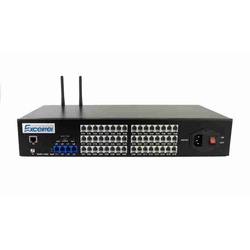
Panatron PXT 632 PABX Capability 6 Line 32 Extension (Default 24 extension) PXT 632
by Panasonic
The Panatron PXT 632 PABX is a communication system with a capability of handling 6 lines and 32 extensions. One of its notable features is the Direct Inward System Access (DISA), which allows external callers to directly access the system by dialing a specific code. With a DISA time limit of 180 seconds, callers have a generous amount of time to interact with the system.
- Direct Inward System Access – 180s in four paragraph
- Auto attendant with both preloaded OGM and self- recording outgoing messages
- Outgoing messages can be stored in the telephone or downloaded to the PC
- Caller ID (external, intercom, transfer Calling Line Identification)
- Incoming call can be forwarded to mobile phone automatically
- Operator/auto-attendant work mode description
| SKU | 1060 |
|---|
Reviews
This product does not have any reviews yet.
Add your reviewDescription
Panatron PXT 632 PABX Capability 6 Line 32 Extension (Default 24 extension) PXT 632
The Panatron PXT 632 PABX is a communication system with a capability of handling 6 lines and 32 extensions. One of its notable features is the Direct Inward System Access (DISA), which allows external callers to directly access the system by dialing a specific code. With a DISA time limit of 180 seconds, callers have a generous amount of time to interact with the system.
The PABX also includes an auto attendant feature, which serves as a virtual receptionist. It can play preloaded outgoing messages (OGM) or record custom messages created by the user. This flexibility enables businesses to tailor their greetings and instructions to suit their specific needs. The auto attendant can handle incoming calls and guide callers through a menu of options to reach the desired destination.
Furthermore, the PXT 632 allows outgoing messages to be stored either in the telephone itself or downloaded to a PC. This feature provides convenience and flexibility for businesses, as they can manage and update their outgoing messages easily.
The Caller ID functionality of the PABX system is comprehensive, supporting identification for external calls, intercom calls, and transfer calls. This feature enables users to know the identity of the caller before answering or transferring the call, enhancing call screening and decision-making processes.
Additionally, the PXT 632 PABX offers the capability to forward incoming calls to a mobile phone automatically. This feature is particularly useful for users who are frequently on the move or away from their desk. Calls can be seamlessly redirected to a designated mobile device, ensuring that important calls are not missed.
The operator/auto-attendant work mode of the PABX system provides different options for handling calls. In the operator mode, incoming calls can be directed to a human operator for manual handling and assistance. On the other hand, the auto-attendant mode allows the system to handle incoming calls automatically, using the predefined menus and options set up by the user. This flexibility enables businesses to choose the most suitable mode of operation based on their specific requirements and preferences.
Key features
-
Call Routing: The PABX system offers flexible call routing options in the operator/auto-attendant work mode. Incoming calls can be directed to the appropriate extension or department based on user-defined rules. This ensures that callers are efficiently connected to the right person or department within the organization.
-
Call Transfer: The operator/auto-attendant work mode allows for seamless call transfers. When a caller needs to be connected to a different extension or department, the operator or auto-attendant can initiate a call transfer. This feature enables efficient call handling and ensures that callers reach their intended destination without hassle.
-
Call Screening: With the caller ID functionality, the PABX system provides call screening capabilities in the operator/auto-attendant work mode. Before answering a call or transferring it, the operator or auto-attendant can view the caller's identification information, including the external caller ID, intercom caller ID, and transfer caller ID. This information allows them to make informed decisions about how to handle the call.
-
Call Queuing: In busy scenarios, the operator/auto-attendant work mode supports call queuing. If all available lines or extensions are busy, incoming calls can be placed in a queue, ensuring that callers do not receive a busy signal. This feature improves customer experience and ensures that calls are handled in an organized and orderly manner.
-
Menu and Prompt Configuration: The PABX system allows users to configure custom menus and prompts for the auto attendant. Users can set up interactive voice response (IVR) menus with pre-recorded prompts to guide callers through various options. This feature provides callers with self-service options and reduces the need for manual intervention from the operator.
-
Time-Based Routing: The operator/auto-attendant work mode supports time-based call routing. Users can define different call handling rules based on specific time periods, such as business hours and after-hours. This feature enables the system to automatically route calls according to the predefined schedule, ensuring efficient call management and appropriate handling during different time periods.

